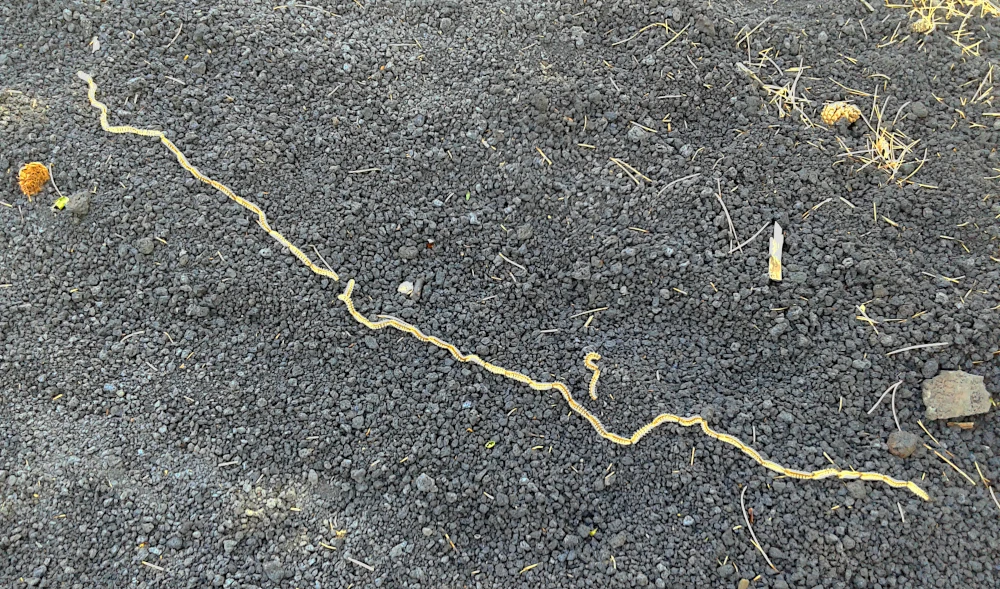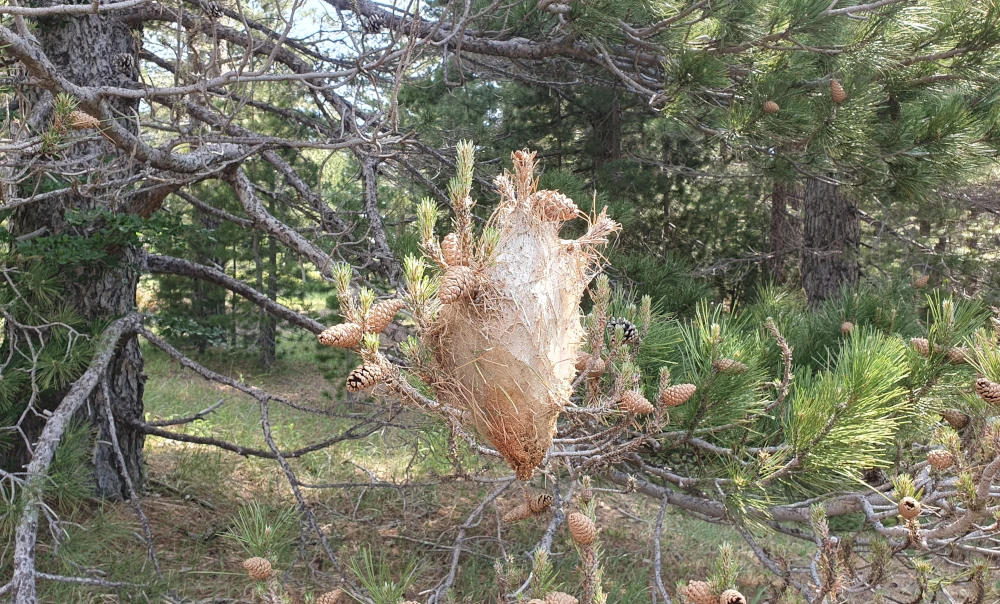If you are on Mount Etna in winter, you will notice numerous white, drop-shaped formations up to 30 cm in size on the pine trees. The nests, spun from thin white threads, sometimes cover the whole tree in dozens.

These are the nests of the pine processionary moth (“la processionaria” in Italian). This butterfly from the moth family has become a real threat in the Mediterranean region and also on Mount Etna.
In this article, we tell you why and what you should bear in mind when hiking on Mount Etna. But let’s start from the beginning.
The life cycle of the pine processionary moth
The caterpillars of the pine processionary moth spend the winter protected in their white nests on the pine trees. As soon as it gets warmer, they crawl out of their nests and begin to eat the pine needles. If there are many caterpillars on a tree, they can empty the tree completely.
The caterpillars crawl off the tree in long chains in spring (between the end of February and the beginning of April, depending on the climatic conditions). One caterpillar after the other marches as if in single file. They form a veritable procession. This is where the name of the butterfly comes from. These chains can be several metres long.

They look for a suitable place underground where they pupate. In summer to autumn, the butterflies hatch and lay their eggs on the trees again. The caterpillars hatch and the cycle begins anew. Before winter, they eat the pine needles and build their nests.
Danger to people and nature
So what makes the pine processionary moth so dangerous and a real invasion on Mount Etna, but also in other areas?
La processionaria has always been native to the Mediterranean. However, as a thermophilic species, it continues to spread due to rising temperatures and mild winters. If too many caterpillars live on a tree, they can cause serious damage to the tree. They inhibit the growth of the tree and can also lead to its death.
But that is not the only danger. Although the butterfly is harmless to humans and animals, the caterpillars are not.
The caterpillar is covered with tiny hairs that are hook-shaped at the end. As a result, they easily attach to the skin when you come into contact with the caterpillars and trigger an allergic reaction. The result is a painful rash. Contact with the eyes can also lead to conjunctivitis.
The wind can also loosen the fine hairs from the caterpillars. Inhaling them can lead to sneezing, a sore throat and, in severe cases, breathing difficulties and bronchospasms.

Distribution
The pine processionary moth is native to the entire Mediterranean region and the Near East. It is found as far north as the Pyrenees, in southern France, Switzerland, South Tyrol and in the north of the Balkans.
It loves dry pine forests like those found in the Mediterranean region.
Countermeasures
The simplest method of combating the pine processionary moth, albeit a time-consuming one, is to remove the nests from the trees manually in winter and burn them. Of course, this requires specialists who wear appropriate protective clothing.
Another option is to attach adhesive strips to the trunk so that the caterpillars stick to them and cannot leave the tree. The butterfly can be caught with pheromone traps so that it can no longer reproduce.
The latest method is to “inoculate” the tree so that it becomes toxic to la processionaria. This involves drilling a hole in the tree and injecting the pesticide so that it can spread throughout the tree.
Unfortunately, far too little is being done against this invasion on Mount Etna. There are not even signs in the affected areas warning of the danger. Many tourists do not know about the pine processionary moth and how to behave correctly.
Precautionary measures for a tour on Mount Etna
Although we have now heard a lot about the dangers of the pine processionary moth, you don’t need to be afraid when you go hiking on Mount Etna.
The most important thing is to be alert! You can recognise the nests of the pine processionary moth from afar, and they live primarily on pine trees. They are not found in the beech or birch forests on Mount Etna.
Do not go close to trees where you can see the nests. If a nest has fallen from a tree and is lying on the path, give it a wide berth. Under no circumstances should you touch the nests.
If you are out and about with your dog, you should take great care that the dog does not lick the nests or caterpillars.
If you still come into contact with the caterpillars, you must consult a doctor immediately!
If you keep all this in mind, nothing stands in the way of an Etna tour!
Of course, it’s best if you’re travelling with one of our guides! Not only will they tell you all about Mount Etna, its flora and fauna, its 300 craters and 560,000 years of history, they will also point out the dangers.
Discover our most popular tours:
Varied tour on the north side of Mount Etna
Discover huge lateral craters, old and new lava flows and a cave that was formed during an eruption.
Valle del Bove and Serracozzo grotto
We hike to the rim of the Valle del Bove and visit one of the most beautiful lava tunnels on Mount Etna. You can run downhill on the soft lava sand as if on snow.
We discover everything Etna has to offer
At almost 3000 metres, we stand directly in front of the summit craters. Below us lies the Valle del Bove, a huge lava desert. We hike along the crater rims and discover a lava tunnel.
The summit of the highest active volcano in Europe
At over 3300 metres, we look directly into the main crater of Mount Etna. A tour for sports enthusiasts looking for adventure.



